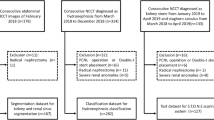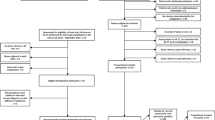Abstract
To develop a fully automatic urinary stone detection system (kidney, ureter, and bladder) and to test it in a real clinical environment. The local institutional review board approved this retrospective single-center study that used non-enhanced abdominopelvic CT scans from patients admitted urology (uPatients) and emergency (ePatients). The uPatients were randomly divided into training and validation sets in a ratio of 3:1. We designed a cascade urinary stone map location-feature pyramid networks (USm-FPNs) and innovatively proposed a ureter distance heatmap method to estimate the ureter position on non-enhanced CT to further reduce the false positives. The performances of the system were compared using the free-response receiver operating characteristic curve and the precision-recall curve. This study included 811 uPatients and 356 ePatients. At stone level, the cascade detector USm-FPNs has the mean of false positives per scan (mFP) 1.88 with the sensitivity 0.977 in validation set, and mFP was further reduced to 1.18 with the sensitivity 0.977 after combining the ureter distance heatmap. At patient level, the sensitivity and precision were as high as 0.995 and 0.990 in validation set, respectively. In a real clinical set of ePatients (27.5% of patients contain stones), the mFP was 1.31 with as high as sensitivity 0.977, and the diagnostic time reduced by > 20% with the system help. A fully automatic detection system for entire urinary stones on non-enhanced CT scans was proposed and reduces obviously the burden on junior radiologists without compromising sensitivity in real emergency data.






Similar content being viewed by others
Data Availability
A data supporting this research is available from the corresponding author on reasonable request.
Abbreviations
- CNNs:
-
Convolutional neural networks
- ePatients:
-
Emergency patients
- FPN:
-
Feature pyramid network
- FROC:
-
Free-response receiver operating characteristic curve
- mFP:
-
Mean of false positives per scan
- PRC:
-
Precision-recall curve
- TP:
-
True positive
- USm-FPNs:
-
Cascade urinary stone map location-feature pyramid networks
- uPatients:
-
Urology patients
References
Stamatelou K, Goldfarb DS. Epidemiology of Kidney Stones. Healthcare (Basel, Switzerland) 2023; 11(3): 424.
Wang W, Fan J, Huang G, Li J, Zhu X, Tian Y, et al. Prevalence of kidney stones in mainland China: A systematic review. Sci Rep 2017; 7: 41630.
Abufaraj M, Xu T, Cao C, Waldhoer T, Seitz C, D'andrea D, et al. Prevalence and trends in kidney stone among adults in the USA: Analyses of national health and nutrition examination survey 2007-2018 data. Eur Urol Focus 2021; 7(6): 1468-1475.
Zhe M, Hang Z. Nephrolithiasis as a risk factor of chronic kidney disease: a meta-analysis of cohort studies with 4,770,691 participants. Urolithiasis 2017; 45(5): 441-448.
Brisbane W, Bailey MR, Sorensen MD. An overview of kidney stone imaging techniques. Nat Rev Urol 2016; 13(11): 654–662.
Kittanamongkolchai W, Vaughan LE, Enders FT, Dhondup T, Mehta RA, Krambeck AE, et al. The changing incidence and presentation of urinary stones over 3 decades. Mayo Clinic proceedings 2018; 93(3): 291-299.
Xiang H, Chan M, Brown V, Huo YR, Chan L, Ridley L. Systematic review and meta-analysis of the diagnostic accuracy of low-dose computed tomography of the kidneys, ureters and bladder for urolithiasis. J Med Imaging Radiat Oncol 2017; 61(5): 582-590.
Alexander R, Waite S, Bruno MA, Krupinski EA, Berlin L, Macknik S, et al. Mandating Limits on Workload, Duty, and Speed in Radiology. Radiology 2022; 304: 274–282.
Längkvist M, Jendeberg J, Thunberg P, Loutfi A, Lidén M. Computer aided detection of ureteral stones in thin slice computed tomography volumes using convolutional neural networks. Comput Biol Med 2018; 97: 153-160.
Liu J, Wang S, Turkbey EB, Linguraru MG, Yao J, Summers RM. Computer-aided detection of renal calculi from noncontrast CT images using TV-flow and MSER features. Med Phys 2015; 42(1): 144-153.
Caglayan A, Horsanali MO, Kocadurdu K, Ismailoglu E, Guneyli S. Deep learning model-assisted detection of kidney stones on computed tomography. Int Braz J Urol 2022; 48(5): 830-839.
Baygin M, Yaman O, Barua PD, Dogan S, Tuncer T, Acharya UR. Exemplar Darknet19 feature generation technique for automated kidney stone detection with coronal CT images. Artif Intell Med 2022; 127: 102274.
Yildirim K, Bozdag PG, Talo M, Yildirim O, Karabatak M, Acharya UR. Deep learning model for automated kidney stone detection using coronal CT images. Comput Biol Med 2021; 135: 104569.
Parakh A, Lee H, Lee JH, Eisner BH, Sahani DV, Do S. Urinary stone detection on CT images using deep convolutional neural networks: Evaluation of model performance and generalization. Radiol Artif Intell 2019; 1(4): e180066.
Jendeberg J, Thunberg P, Lidén M. Differentiation of distal ureteral stones and pelvic phleboliths using a convolutional neural network. Urolithiasis 2021; 49(1): 41-49.
Memarsadeghi M, Heinz-Peer G, Helbich TH, Schaefer-Prokop C, Kramer G, Scharitzer M, et al. Unenhanced multi-detector row CT in patients suspected of having urinary stone disease: effect of section width on diagnosis. Radiology 2005; 235(2): 530-536.
Mileto A, Guimaraes LS, McCollough CH, Fletcher JG, Yu L. State of the art in abdominal CT: The limits of iterative reconstruction algorithms. Radiology 2019; 293(3): 491-503.
Malkawi IM, Han E, Atalla CS, Santucci RA, O'Neil B, Wynberg JB. Low-Dose (10%) computed tomography may be inferior to standard-dose CT in the evaluation of acute renal colic in the emergency room setting. J Endourol 2016; 30(5): 493-496.
Mohammadinejad P, Mileto A, Yu L, Leng S, Guimaraes LS, Missert AD, et al. CT noise-reduction methods for lower-dose scanning: strengths and weaknesses of iterative reconstruction algorithms and new techniques. Radiographics 2021; 41(5): 1493-1508.
Wang RC, Rodriguez RM, Moghadassi M, Noble V, Bailitz J, Mallin M, et al. External validation of the STONE score, a clinical prediction rule for ureteral stone: An observational multi-institutional study. Ann Emerg Med 2016; 67(4): 423-432.e2.
Wu J, Xia Y, Wang X, Wei Y, Liu A, Innanje A, et al. uRP: An integrated research platform for one-stop analysis of medical images. Front Radiol 2023; 3: 1153784.
Mu G, Lin Z, Han M, Yao G, Gao Y. Segmentation of kidney tumor by multi-resolution VB-nets. 2019 Kidney Tumor Segmentation Challenge: KiTS19. https://doi.org/10.24926/548719.003, 2019
Zhu W, Huang H, Zhou Y, Shi F, Shen H, Chen R, et al. Automatic segmentation of white matter hyperintensities in routine clinical brain MRI by 2D VB-Net: A large-scale study. Front Aging Neurosci 2022; 14: 915009.
Milletari F, Navab N, Ahmadi SA. V-net: fully convolutional neural networks for volumetric medical image segmentation. IEEE. https://doi.org/10.48550/arXiv.1606.04797, 2016
Xiao Y, Wang X, Li Q, Fan R, Chen R, Shao Y, et al. A cascade and heterogeneous neural network for CT pulmonary nodule detection and its evaluation on both phantom and patient data. Comput Med Imaging Graph 2021; 90: 101889.
Meng XH, Wu DJ, Wang Z, Ma XL, Dong XM, Liu AE, et al. A fully automated rib fracture detection system on chest CT images and its impact on radiologist performance. Skeletal Radiol 2021; 50(9): 1821-1828.
Wu K, Gu D, Qi P, Cao X, Wu D, Chen L, et al. Evaluation of an automated intracranial aneurysm detection and rupture analysis approach using cascade detection and classification networks. Comput Med Imaging Graph 2022; 102: 102126.
Elton DC, Turkbey EB, Pickhardt PJ, Summers RM. A deep learning system for automated kidney stone detection and volumetric segmentation on noncontrast CT scans. Med Phys 2022; 49(4): 2545-2554.
Jendeberg J, Geijer H, Alshamari M, Cierzniak B, Lidén M. Size matters: The width and location of a ureteral stone accurately predict the chance of spontaneous passage. Eur Radiol 2017; 27(11): 4775-4785.
Author information
Authors and Affiliations
Corresponding authors
Ethics declarations
Ethics Approval
This retrospective cross-section study was approved by the local institutional review board. Informed consent was waived for the retrospective study.
Competing Interest
The authors declare no competing interests.
Additional information
Publisher's Note
Springer Nature remains neutral with regard to jurisdictional claims in published maps and institutional affiliations.
Rights and permissions
Springer Nature or its licensor (e.g. a society or other partner) holds exclusive rights to this article under a publishing agreement with the author(s) or other rightsholder(s); author self-archiving of the accepted manuscript version of this article is solely governed by the terms of such publishing agreement and applicable law.
About this article
Cite this article
Xing, Z., Zhu, Z., Jiang, Z. et al. Automatic Urinary Stone Detection System for Abdominal Non-Enhanced CT Images Reduces the Burden on Radiologists. J Digit Imaging. Inform. med. 37, 444–454 (2024). https://doi.org/10.1007/s10278-023-00946-2
Received:
Revised:
Accepted:
Published:
Issue Date:
DOI: https://doi.org/10.1007/s10278-023-00946-2




